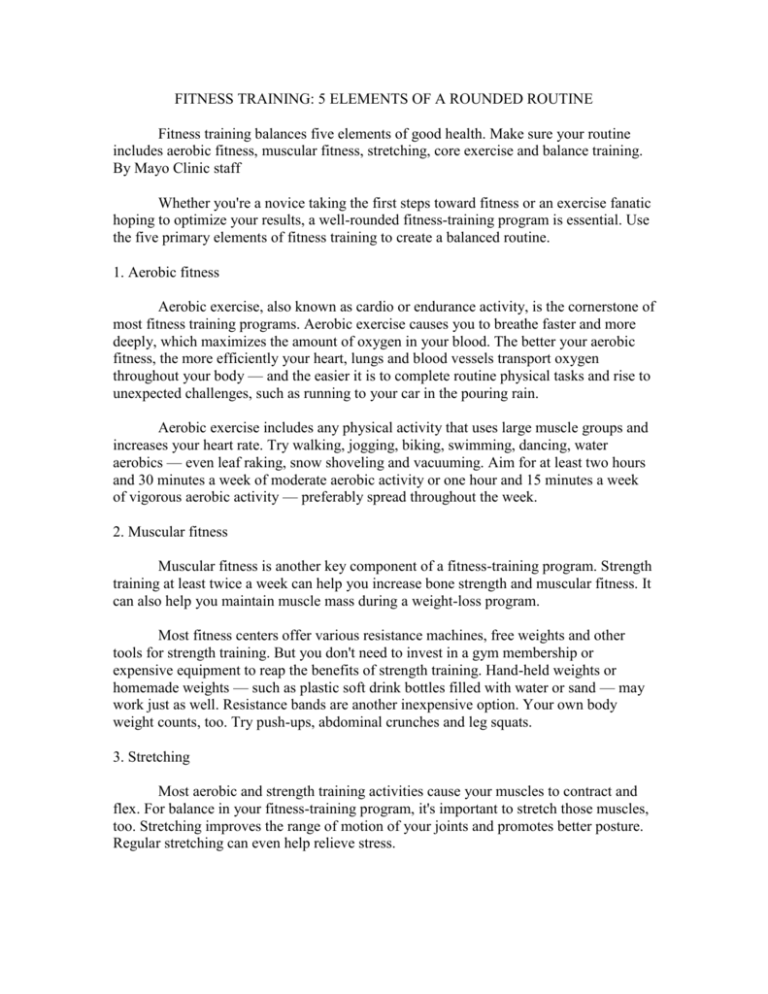Fitness training: 5 elements of a rounded routine
advertisement

FITNESS TRAINING: 5 ELEMENTS OF A ROUNDED ROUTINE Fitness training balances five elements of good health. Make sure your routine includes aerobic fitness, muscular fitness, stretching, core exercise and balance training. By Mayo Clinic staff Whether you're a novice taking the first steps toward fitness or an exercise fanatic hoping to optimize your results, a well-rounded fitness-training program is essential. Use the five primary elements of fitness training to create a balanced routine. 1. Aerobic fitness Aerobic exercise, also known as cardio or endurance activity, is the cornerstone of most fitness training programs. Aerobic exercise causes you to breathe faster and more deeply, which maximizes the amount of oxygen in your blood. The better your aerobic fitness, the more efficiently your heart, lungs and blood vessels transport oxygen throughout your body — and the easier it is to complete routine physical tasks and rise to unexpected challenges, such as running to your car in the pouring rain. Aerobic exercise includes any physical activity that uses large muscle groups and increases your heart rate. Try walking, jogging, biking, swimming, dancing, water aerobics — even leaf raking, snow shoveling and vacuuming. Aim for at least two hours and 30 minutes a week of moderate aerobic activity or one hour and 15 minutes a week of vigorous aerobic activity — preferably spread throughout the week. 2. Muscular fitness Muscular fitness is another key component of a fitness-training program. Strength training at least twice a week can help you increase bone strength and muscular fitness. It can also help you maintain muscle mass during a weight-loss program. Most fitness centers offer various resistance machines, free weights and other tools for strength training. But you don't need to invest in a gym membership or expensive equipment to reap the benefits of strength training. Hand-held weights or homemade weights — such as plastic soft drink bottles filled with water or sand — may work just as well. Resistance bands are another inexpensive option. Your own body weight counts, too. Try push-ups, abdominal crunches and leg squats. 3. Stretching Most aerobic and strength training activities cause your muscles to contract and flex. For balance in your fitness-training program, it's important to stretch those muscles, too. Stretching improves the range of motion of your joints and promotes better posture. Regular stretching can even help relieve stress. Before you stretch, warm up by walking or doing a favorite exercise at low intensity for five to 10 minutes. Better yet, stretch after you exercise — when your muscles are warm and receptive to stretching. Ideally, you'll stretch whenever you exercise. If you don't exercise regularly, you might want to stretch at least three times a week after warming up to maintain flexibility. Activities such as yoga promote flexibility, too. 4. Core stability The muscles in your abdomen, lower back and pelvis — known as your core muscles — help protect your back and connect upper and lower body movements. Core strength is a key element of a well-rounded fitness-training program. Core exercises help train your muscles to brace the spine and enable you to use your upper and lower body muscles more effectively. So what counts as a core exercise? Any exercise that uses the trunk of your body without support, including abdominal crunches. You can also try various core exercises with a fitness ball. 5. Balance training You can be strong, flexible and aerobically fit, yet still have poor balance. Training can help you maintain and improve balance. This is important since balance tends to deteriorate with age, which can lead to falls and fractures. Try standing on one leg for increasing periods of time to improve your overall stability. Activities such as tai chi can promote balance, too. Cover all five elements Whether you create your own fitness-training program or enlist the help of a personal trainer, make aerobic fitness, muscular fitness, stretching, core exercise and balance training part of your overall exercise plan. It isn't necessary to fit each of the five elements into every fitness session, but factoring them into your regular routine can help you promote fitness for life. NAME: 1. Name the five components of good health. 2. Why improve your aerobic fitness? 3. What are some ways to improve your aerobic fitness? 4. How much aerobic fitness training should you do a week? 5. How often do you need to strength train? 6. What does strength training help improve? 7. Give the benefits of increasing flexibility. 8. What muscles make up you “core”? 9. What do core exercises do? 10. Name three types of core exercises. 11. What are some of the hazards (problems) of having poor balance?





